Comprehensive Risk Management Report: Standards and Mitigation
VerifiedAdded on 2022/12/29
|6
|1151
|41
Report
AI Summary
This report provides a comprehensive overview of risk management, focusing on the ISO 31000 standard. It explores various aspects, including the framework, guidelines, and processes for managing risk within organizations of any size. The report details supporting standards like IEC 31010 and ISO Guide 73, highlighting the importance of international standards such as ISO/TS 16949 in the automotive industry. It also examines the influence of legislation, codes of conduct, and national standards on risk management strategies. Furthermore, the report provides examples of different types of risks, including strategic, insurance, financial, operational, and re-insurance risks. It analyzes how insurance can mitigate risks such as cyber risk, defamation, and construction risks. Finally, the report discusses workplace adjustments for disabled individuals, emphasizing the importance of providing appropriate support and accommodations.
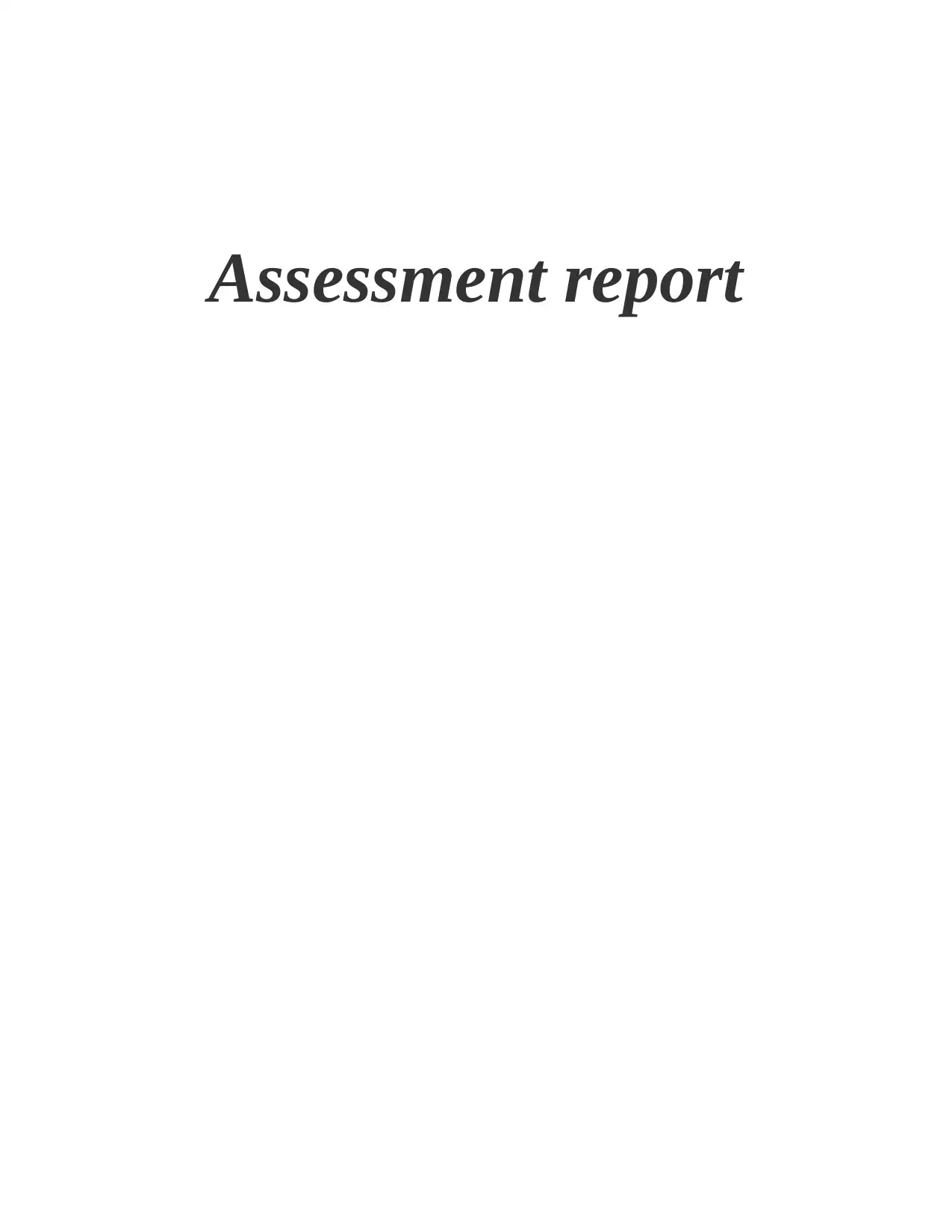
Assessment report
Paraphrase This Document
Need a fresh take? Get an instant paraphrase of this document with our AI Paraphraser
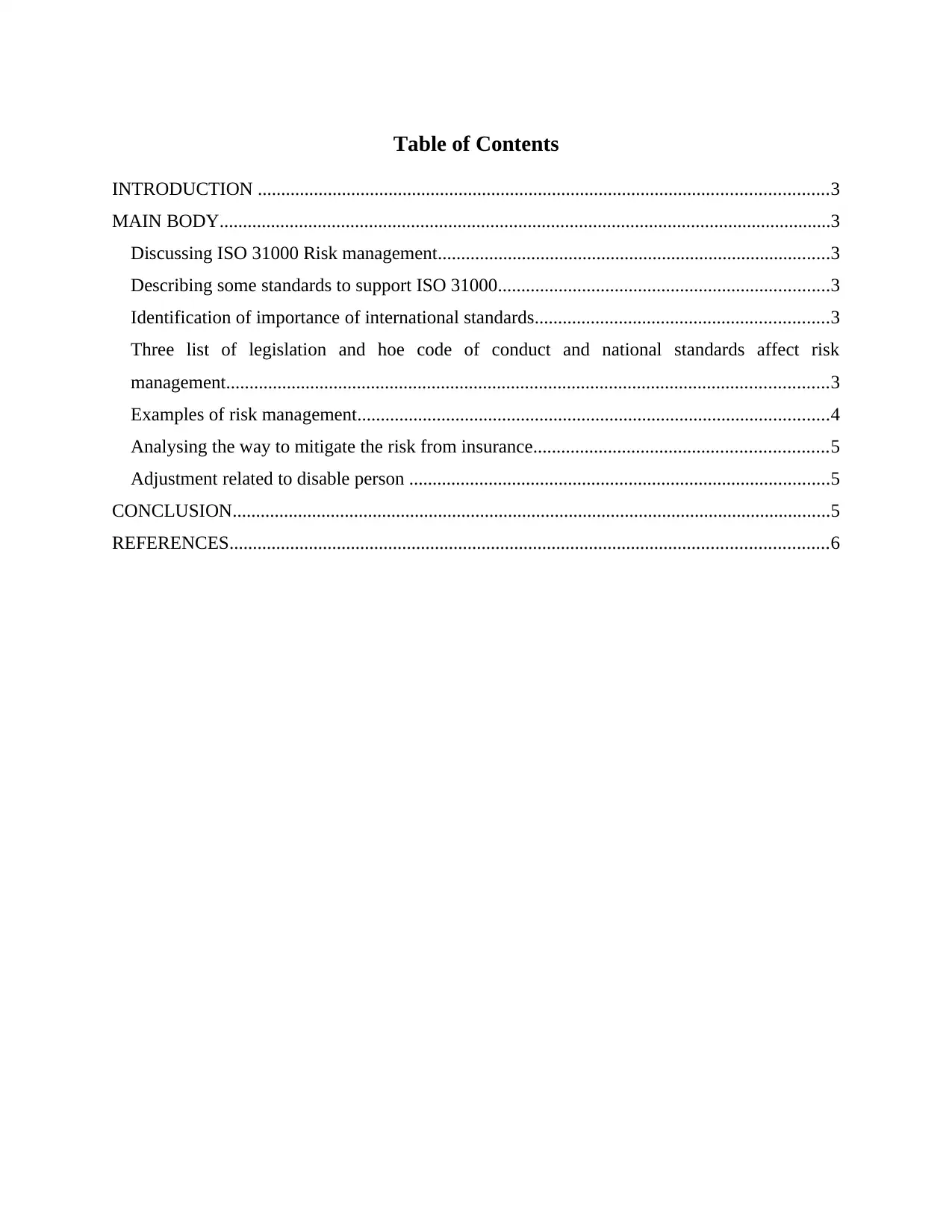
Table of Contents
INTRODUCTION ..........................................................................................................................3
MAIN BODY...................................................................................................................................3
Discussing ISO 31000 Risk management....................................................................................3
Describing some standards to support ISO 31000.......................................................................3
Identification of importance of international standards...............................................................3
Three list of legislation and hoe code of conduct and national standards affect risk
management.................................................................................................................................3
Examples of risk management.....................................................................................................4
Analysing the way to mitigate the risk from insurance...............................................................5
Adjustment related to disable person ..........................................................................................5
CONCLUSION................................................................................................................................5
REFERENCES................................................................................................................................6
INTRODUCTION ..........................................................................................................................3
MAIN BODY...................................................................................................................................3
Discussing ISO 31000 Risk management....................................................................................3
Describing some standards to support ISO 31000.......................................................................3
Identification of importance of international standards...............................................................3
Three list of legislation and hoe code of conduct and national standards affect risk
management.................................................................................................................................3
Examples of risk management.....................................................................................................4
Analysing the way to mitigate the risk from insurance...............................................................5
Adjustment related to disable person ..........................................................................................5
CONCLUSION................................................................................................................................5
REFERENCES................................................................................................................................6
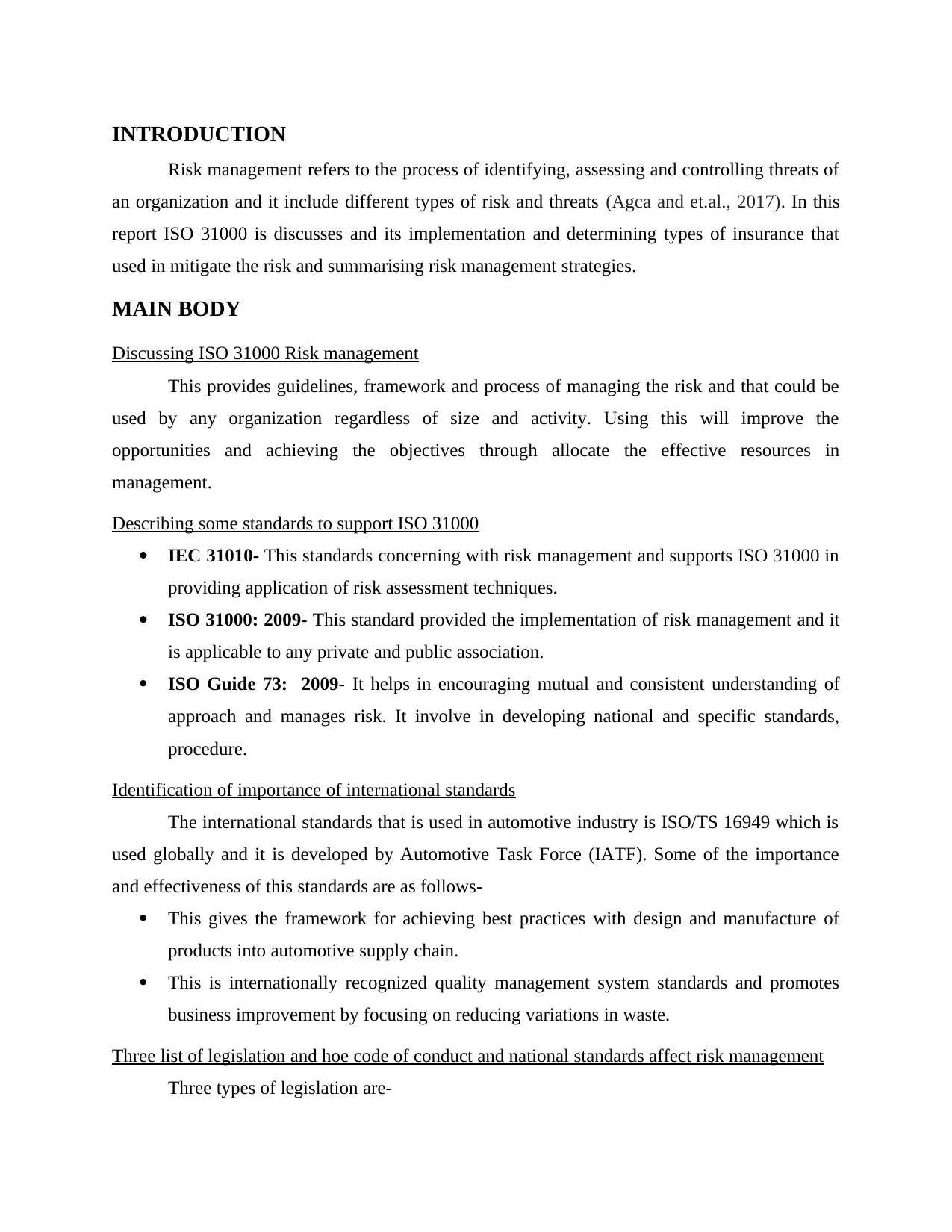
INTRODUCTION
Risk management refers to the process of identifying, assessing and controlling threats of
an organization and it include different types of risk and threats (Agca and et.al., 2017). In this
report ISO 31000 is discusses and its implementation and determining types of insurance that
used in mitigate the risk and summarising risk management strategies.
MAIN BODY
Discussing ISO 31000 Risk management
This provides guidelines, framework and process of managing the risk and that could be
used by any organization regardless of size and activity. Using this will improve the
opportunities and achieving the objectives through allocate the effective resources in
management.
Describing some standards to support ISO 31000
IEC 31010- This standards concerning with risk management and supports ISO 31000 in
providing application of risk assessment techniques.
ISO 31000: 2009- This standard provided the implementation of risk management and it
is applicable to any private and public association.
ISO Guide 73: 2009- It helps in encouraging mutual and consistent understanding of
approach and manages risk. It involve in developing national and specific standards,
procedure.
Identification of importance of international standards
The international standards that is used in automotive industry is ISO/TS 16949 which is
used globally and it is developed by Automotive Task Force (IATF). Some of the importance
and effectiveness of this standards are as follows-
This gives the framework for achieving best practices with design and manufacture of
products into automotive supply chain.
This is internationally recognized quality management system standards and promotes
business improvement by focusing on reducing variations in waste.
Three list of legislation and hoe code of conduct and national standards affect risk management
Three types of legislation are-
Risk management refers to the process of identifying, assessing and controlling threats of
an organization and it include different types of risk and threats (Agca and et.al., 2017). In this
report ISO 31000 is discusses and its implementation and determining types of insurance that
used in mitigate the risk and summarising risk management strategies.
MAIN BODY
Discussing ISO 31000 Risk management
This provides guidelines, framework and process of managing the risk and that could be
used by any organization regardless of size and activity. Using this will improve the
opportunities and achieving the objectives through allocate the effective resources in
management.
Describing some standards to support ISO 31000
IEC 31010- This standards concerning with risk management and supports ISO 31000 in
providing application of risk assessment techniques.
ISO 31000: 2009- This standard provided the implementation of risk management and it
is applicable to any private and public association.
ISO Guide 73: 2009- It helps in encouraging mutual and consistent understanding of
approach and manages risk. It involve in developing national and specific standards,
procedure.
Identification of importance of international standards
The international standards that is used in automotive industry is ISO/TS 16949 which is
used globally and it is developed by Automotive Task Force (IATF). Some of the importance
and effectiveness of this standards are as follows-
This gives the framework for achieving best practices with design and manufacture of
products into automotive supply chain.
This is internationally recognized quality management system standards and promotes
business improvement by focusing on reducing variations in waste.
Three list of legislation and hoe code of conduct and national standards affect risk management
Three types of legislation are-
⊘ This is a preview!⊘
Do you want full access?
Subscribe today to unlock all pages.

Trusted by 1+ million students worldwide
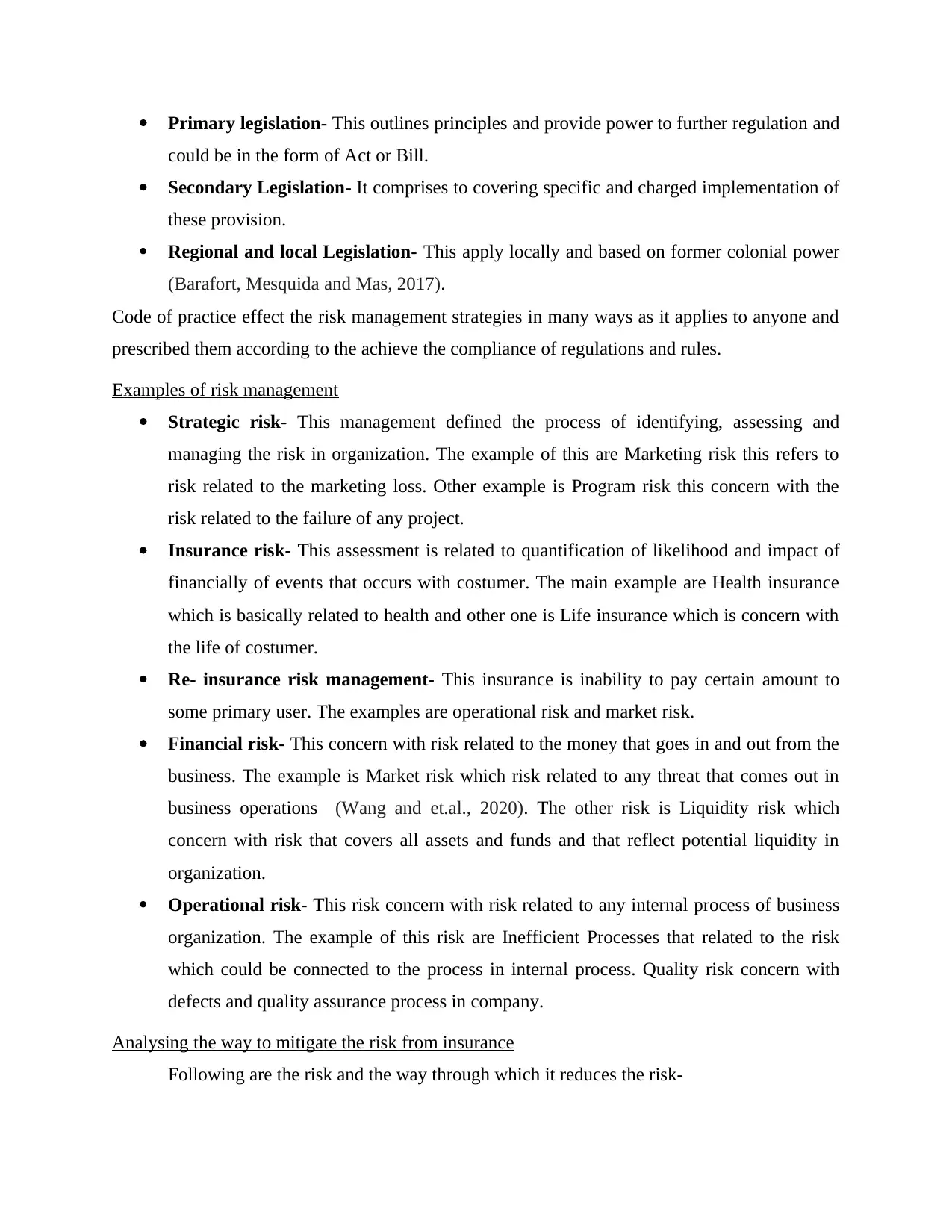
Primary legislation- This outlines principles and provide power to further regulation and
could be in the form of Act or Bill.
Secondary Legislation- It comprises to covering specific and charged implementation of
these provision.
Regional and local Legislation- This apply locally and based on former colonial power
(Barafort, Mesquida and Mas, 2017).
Code of practice effect the risk management strategies in many ways as it applies to anyone and
prescribed them according to the achieve the compliance of regulations and rules.
Examples of risk management
Strategic risk- This management defined the process of identifying, assessing and
managing the risk in organization. The example of this are Marketing risk this refers to
risk related to the marketing loss. Other example is Program risk this concern with the
risk related to the failure of any project.
Insurance risk- This assessment is related to quantification of likelihood and impact of
financially of events that occurs with costumer. The main example are Health insurance
which is basically related to health and other one is Life insurance which is concern with
the life of costumer.
Re- insurance risk management- This insurance is inability to pay certain amount to
some primary user. The examples are operational risk and market risk.
Financial risk- This concern with risk related to the money that goes in and out from the
business. The example is Market risk which risk related to any threat that comes out in
business operations (Wang and et.al., 2020). The other risk is Liquidity risk which
concern with risk that covers all assets and funds and that reflect potential liquidity in
organization.
Operational risk- This risk concern with risk related to any internal process of business
organization. The example of this risk are Inefficient Processes that related to the risk
which could be connected to the process in internal process. Quality risk concern with
defects and quality assurance process in company.
Analysing the way to mitigate the risk from insurance
Following are the risk and the way through which it reduces the risk-
could be in the form of Act or Bill.
Secondary Legislation- It comprises to covering specific and charged implementation of
these provision.
Regional and local Legislation- This apply locally and based on former colonial power
(Barafort, Mesquida and Mas, 2017).
Code of practice effect the risk management strategies in many ways as it applies to anyone and
prescribed them according to the achieve the compliance of regulations and rules.
Examples of risk management
Strategic risk- This management defined the process of identifying, assessing and
managing the risk in organization. The example of this are Marketing risk this refers to
risk related to the marketing loss. Other example is Program risk this concern with the
risk related to the failure of any project.
Insurance risk- This assessment is related to quantification of likelihood and impact of
financially of events that occurs with costumer. The main example are Health insurance
which is basically related to health and other one is Life insurance which is concern with
the life of costumer.
Re- insurance risk management- This insurance is inability to pay certain amount to
some primary user. The examples are operational risk and market risk.
Financial risk- This concern with risk related to the money that goes in and out from the
business. The example is Market risk which risk related to any threat that comes out in
business operations (Wang and et.al., 2020). The other risk is Liquidity risk which
concern with risk that covers all assets and funds and that reflect potential liquidity in
organization.
Operational risk- This risk concern with risk related to any internal process of business
organization. The example of this risk are Inefficient Processes that related to the risk
which could be connected to the process in internal process. Quality risk concern with
defects and quality assurance process in company.
Analysing the way to mitigate the risk from insurance
Following are the risk and the way through which it reduces the risk-
Paraphrase This Document
Need a fresh take? Get an instant paraphrase of this document with our AI Paraphraser
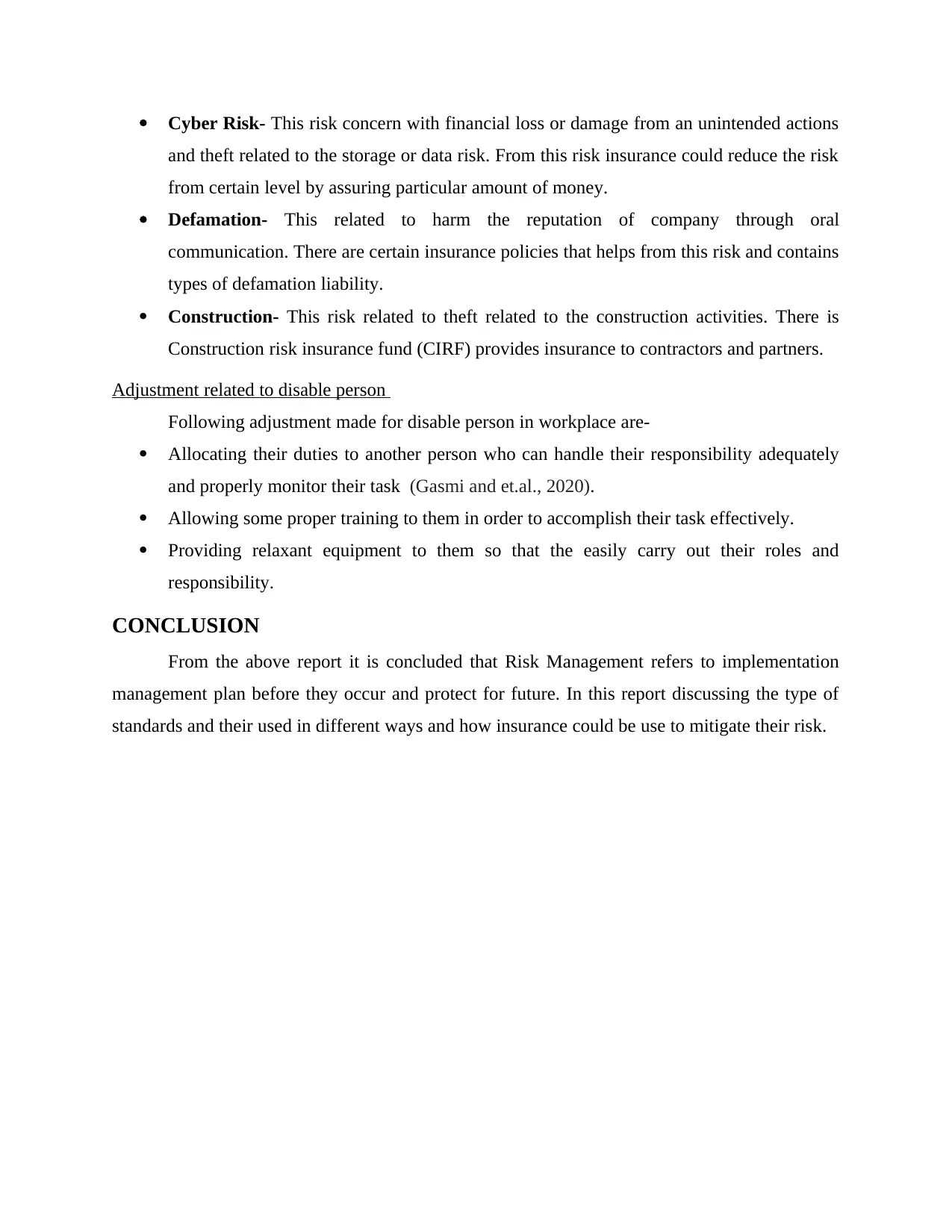
Cyber Risk- This risk concern with financial loss or damage from an unintended actions
and theft related to the storage or data risk. From this risk insurance could reduce the risk
from certain level by assuring particular amount of money.
Defamation- This related to harm the reputation of company through oral
communication. There are certain insurance policies that helps from this risk and contains
types of defamation liability.
Construction- This risk related to theft related to the construction activities. There is
Construction risk insurance fund (CIRF) provides insurance to contractors and partners.
Adjustment related to disable person
Following adjustment made for disable person in workplace are-
Allocating their duties to another person who can handle their responsibility adequately
and properly monitor their task (Gasmi and et.al., 2020).
Allowing some proper training to them in order to accomplish their task effectively.
Providing relaxant equipment to them so that the easily carry out their roles and
responsibility.
CONCLUSION
From the above report it is concluded that Risk Management refers to implementation
management plan before they occur and protect for future. In this report discussing the type of
standards and their used in different ways and how insurance could be use to mitigate their risk.
and theft related to the storage or data risk. From this risk insurance could reduce the risk
from certain level by assuring particular amount of money.
Defamation- This related to harm the reputation of company through oral
communication. There are certain insurance policies that helps from this risk and contains
types of defamation liability.
Construction- This risk related to theft related to the construction activities. There is
Construction risk insurance fund (CIRF) provides insurance to contractors and partners.
Adjustment related to disable person
Following adjustment made for disable person in workplace are-
Allocating their duties to another person who can handle their responsibility adequately
and properly monitor their task (Gasmi and et.al., 2020).
Allowing some proper training to them in order to accomplish their task effectively.
Providing relaxant equipment to them so that the easily carry out their roles and
responsibility.
CONCLUSION
From the above report it is concluded that Risk Management refers to implementation
management plan before they occur and protect for future. In this report discussing the type of
standards and their used in different ways and how insurance could be use to mitigate their risk.
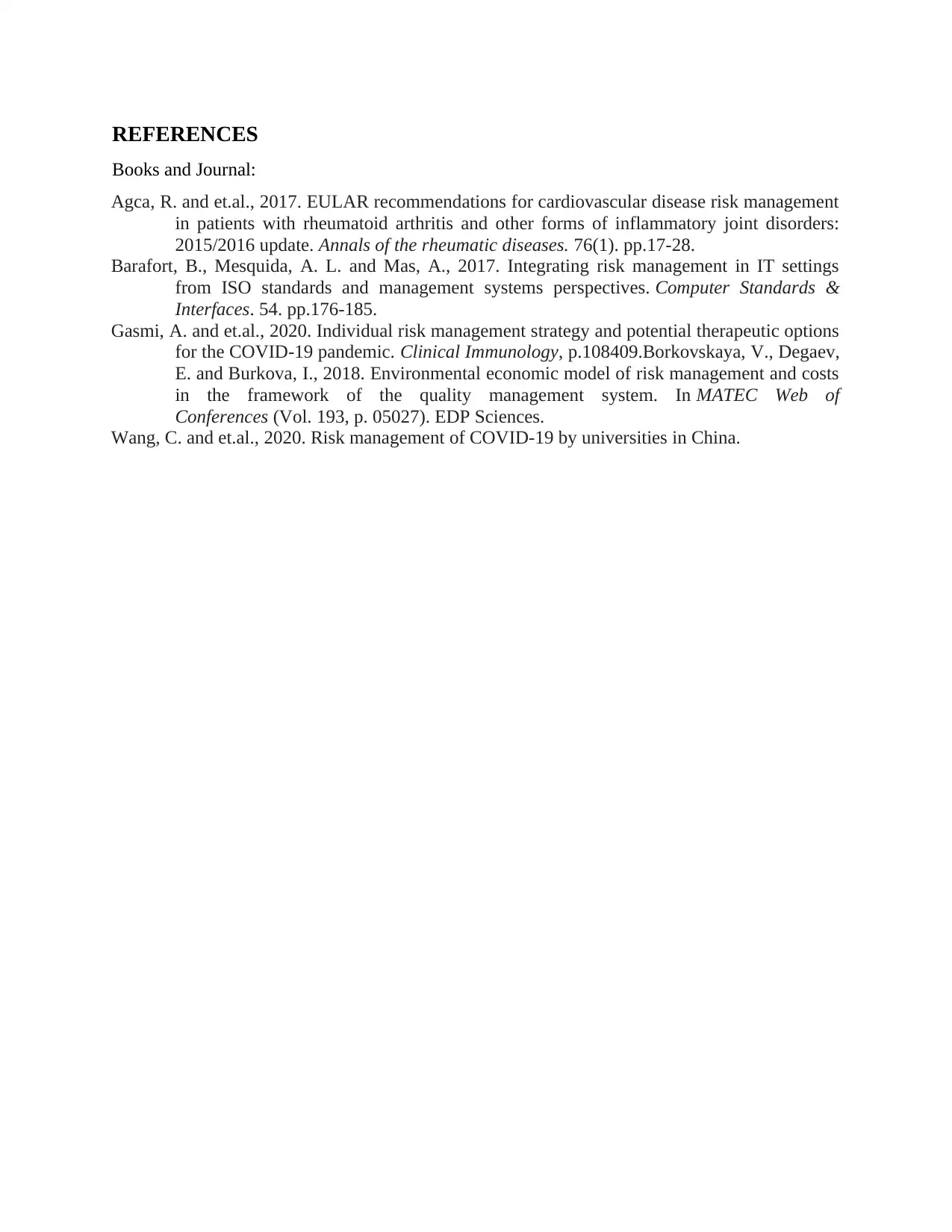
REFERENCES
Books and Journal:
Agca, R. and et.al., 2017. EULAR recommendations for cardiovascular disease risk management
in patients with rheumatoid arthritis and other forms of inflammatory joint disorders:
2015/2016 update. Annals of the rheumatic diseases. 76(1). pp.17-28.
Barafort, B., Mesquida, A. L. and Mas, A., 2017. Integrating risk management in IT settings
from ISO standards and management systems perspectives. Computer Standards &
Interfaces. 54. pp.176-185.
Gasmi, A. and et.al., 2020. Individual risk management strategy and potential therapeutic options
for the COVID-19 pandemic. Clinical Immunology, p.108409.Borkovskaya, V., Degaev,
E. and Burkova, I., 2018. Environmental economic model of risk management and costs
in the framework of the quality management system. In MATEC Web of
Conferences (Vol. 193, p. 05027). EDP Sciences.
Wang, C. and et.al., 2020. Risk management of COVID-19 by universities in China.
Books and Journal:
Agca, R. and et.al., 2017. EULAR recommendations for cardiovascular disease risk management
in patients with rheumatoid arthritis and other forms of inflammatory joint disorders:
2015/2016 update. Annals of the rheumatic diseases. 76(1). pp.17-28.
Barafort, B., Mesquida, A. L. and Mas, A., 2017. Integrating risk management in IT settings
from ISO standards and management systems perspectives. Computer Standards &
Interfaces. 54. pp.176-185.
Gasmi, A. and et.al., 2020. Individual risk management strategy and potential therapeutic options
for the COVID-19 pandemic. Clinical Immunology, p.108409.Borkovskaya, V., Degaev,
E. and Burkova, I., 2018. Environmental economic model of risk management and costs
in the framework of the quality management system. In MATEC Web of
Conferences (Vol. 193, p. 05027). EDP Sciences.
Wang, C. and et.al., 2020. Risk management of COVID-19 by universities in China.
⊘ This is a preview!⊘
Do you want full access?
Subscribe today to unlock all pages.

Trusted by 1+ million students worldwide
1 out of 6
Related Documents
Your All-in-One AI-Powered Toolkit for Academic Success.
+13062052269
info@desklib.com
Available 24*7 on WhatsApp / Email
![[object Object]](/_next/static/media/star-bottom.7253800d.svg)
Unlock your academic potential
Copyright © 2020–2025 A2Z Services. All Rights Reserved. Developed and managed by ZUCOL.




